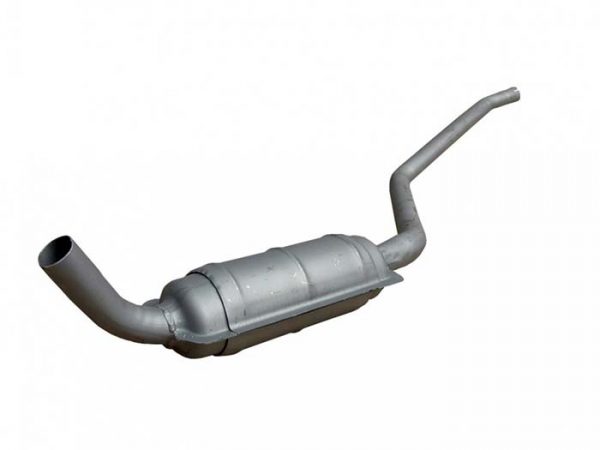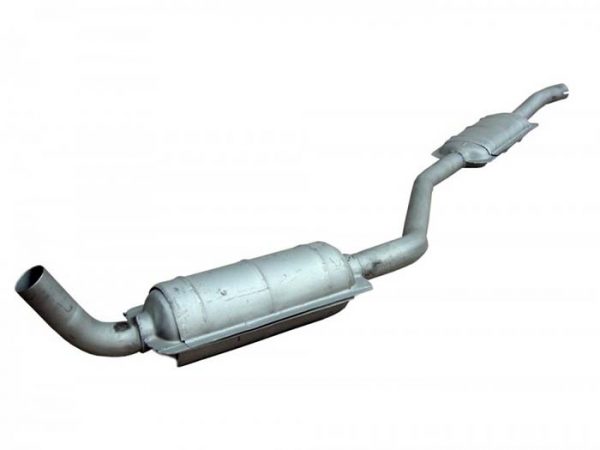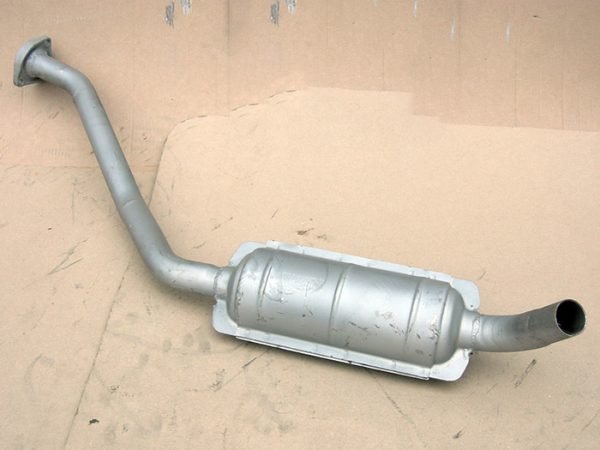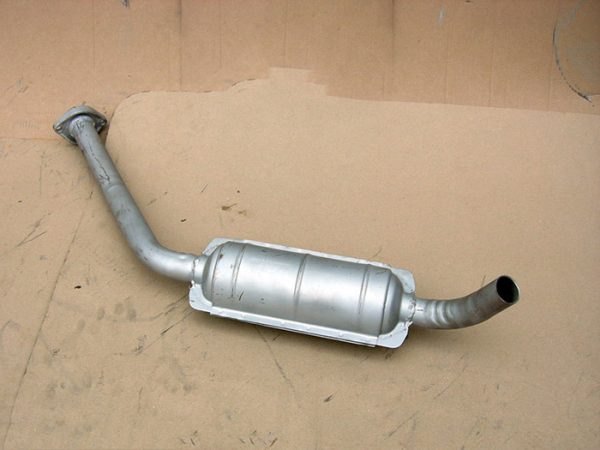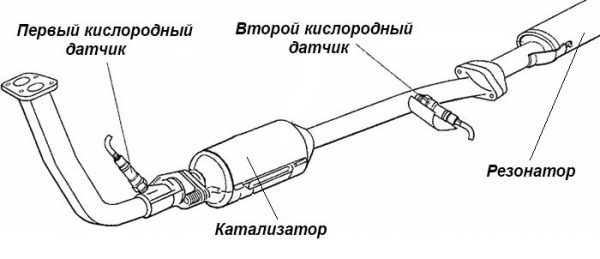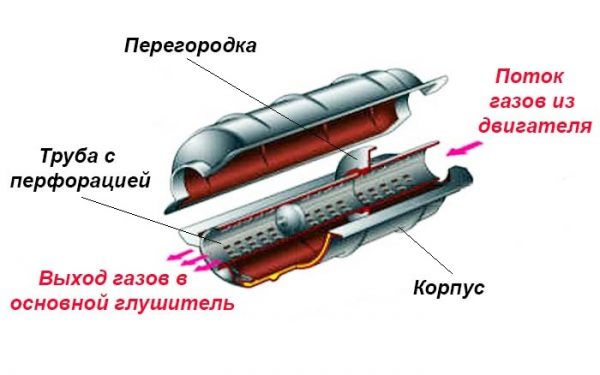
Repair and replacement of the resonator on the VAZ 2107: do it yourself
Content
The exhaust system of classic VAZ models consists of three elements. The middle element is usually called a resonator. Any malfunction is accompanied by a roar coming from under the bottom of the car. Do-it-yourself repair and replacement of the resonator is quite simple. In this case, the choice of a new part is of particular relevance - the manufacturer installed several types of resonators on the VAZ 2107, depending on the type of engine and power system.
The device and purpose of the resonator VAZ 2107
The resonator is a cylindrical metal tank designed to preliminarily reduce the sound of the exhaust. Connecting pipes with a diameter of 40 mm are hermetically welded to it in front and behind. The front pipe is equipped with a counter flange for a catalyst or a downpipe, and the rear pipe has two longitudinal slots for joining with the muffler section.
Resonator pipes for carburetor models VAZ 2106-2107 are equipped with one or two tanks. The first type was installed on cars with an engine capacity of up to 1,3 liters, the second - on modifications with more powerful engines of 1,5-1,6 liters.
The resonator consists of:
- tightly sealed cylindrical body, to which the connecting pipes are welded;
- an inner pipe with a large number of holes (perforations) for passing exhaust gases;
- a transverse partition dividing the body into two internal chambers.

The principle of operation of the resonator is based on the phenomenon of sound resonance. Getting together with the exhaust gases inside the housing, sound waves penetrate through the perforation in the pipe and are repeatedly reflected from the outer walls of the tank. There is a mutual damping of oscillations, and the amplitude of the waves decreases. As a result, the volume of the exhaust sound is significantly reduced.
The VAZ 2107 resonator performs the following functions:
- pre-reduces the exhaust sound level;
- unlike the main muffler, it practically does not create resistance to the exhaust flow;
- contributes to the cooling of hot gas;
- taking on part of the load, prolongs the life of the main muffler.
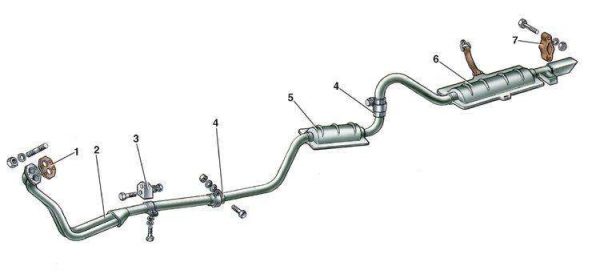
The location of the resonator VAZ 2107
The exhaust system of carburetor VAZ 2107 consists of three sections:
- double downpipe attached to the exhaust manifold flange;
- resonator;
- main muffler.
A similar system was installed on the first sevens with an injector that complied with Euro 0 standards. Later, injection modifications of the VAZ 2107 appeared, produced in accordance with the requirements of Euro 2 and Euro 3, in which the exhaust tract was supplemented by a fourth section - a catalytic converter located between the intake and resonator pipes .
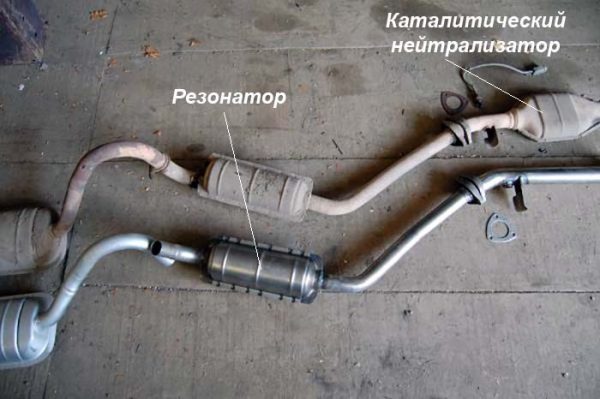
The resonator, connected by the front to the exhaust pipe or catalytic converter, starts under the gearbox and ends in front of the rear axle beam. The resonator tank is located to the right (in the direction of travel) of the cardan shaft. The connecting pipe coming out of the body is bent upwards and docked with the pipe of the main muffler, which goes around the rear axle. The whole structure rests on the engine exhaust manifold flange, a metal bracket and rubber hangers attached to the bottom of the car.
Choosing a resonator for the VAZ 2107
Four types of resonators are installed on the VAZ 2107:
- Long section with one tank. It is installed on all classic carburetor VAZ 2101-2107 with an engine capacity of not more than 1,3 liters. The catalog number is 2101–1202005.
 A resonator with one tank is used to dampen the noise of small engines
A resonator with one tank is used to dampen the noise of small engines - Long section with two tanks. It is installed on carburetor and injection VAZ 2106-07, corresponding to Euro 0 standards, with an engine capacity of 1,5-1,6 liters. The catalog number is 2103–1202005.
 On models with increased power engines, the manufacturer installed pipes with two resonator tanks
On models with increased power engines, the manufacturer installed pipes with two resonator tanks - A shortened pipe with one tank and a front mounting flange for two mounting bolts. It is installed on injector VAZ 2106-07 that meet the requirements of Euro 2. Catalog number - 21073-1200020.
 The resonator of injector VAZ 2106–07 that meets the requirements of Euro 2 is shortened and equipped with a flange for installing a catalyst
The resonator of injector VAZ 2106–07 that meets the requirements of Euro 2 is shortened and equipped with a flange for installing a catalyst - Short section with one barrel and a front flange for three fixing bolts. It is installed on injector VAZ 2106-07 that meet the requirements of Euro 3. Catalog number - 21074-1200020.
 In VAZ 21074 cars there is a larger converter, so the resonator section is greatly shortened
In VAZ 21074 cars there is a larger converter, so the resonator section is greatly shortened
The last two types of resonators are shortened due to the addition of an additional element - a catalytic converter. Parts for Euro 2 and 3 differ in length (the spare part for Euro 3 is shorter) and the number of fixing bolts on the flange. The second tank is missing - its functions are performed by a catalyst.

The choice of resonator depends on the specific modification of the VAZ 2107. When buying, keep in mind the following recommendations:
- On the carburetor version with a 1,3 liter engine, you can easily put a long section with one (VAZ 2101-07) or two (VAZ 2106-07) tanks. In the second case, the sound of a running engine will become quieter, but the power will drop by about 3-5 liters. With. Shortened resonators will not work.
- Both long resonators are suitable for carburetor and injection VAZ 2107 that comply with Euro 0. When installing a part with one tank, the exhaust noise will increase, and the engine power will increase slightly. Short pipes must not be installed.
- The exhaust system for Euro 2 is equipped not only with a catalyst, but also with an oxygen sensor (lambda probe) mounted in the exhaust pipe. For such cars, a native shortened resonator with a two-bolt flange or any long section is suitable. However, such a resonator is not suitable for the VAZ 2107 Euro - it fits with another catalyst and differs in length.
- The exhaust system of the VAZ 2107, manufactured in accordance with Euro 3 standards, has two oxygen sensors. On the VAZ 21074, you can install a native short resonator or a long one, but with some modifications.
 In injection VAZ 2107 that comply with Euro 3 standards, a catalyst with two oxygen sensors is installed in front of the resonator
In injection VAZ 2107 that comply with Euro 3 standards, a catalyst with two oxygen sensors is installed in front of the resonator
It is pointless to put a resonator from other brands of cars and front-wheel drive VAZ models on the "seven". You will have to strongly heat and bend the pipe made of refractory steel. An alternative option is to weld a resonator tank with your own hands on the basis of a burned-out element.

The installation of long sections on the VAZ 2101-07, which complies with Euro 2 and 3 standards, is advisable in cases where it is necessary to discard a failed catalyst. The latter is quite expensive, and not every car owner is ready to make a full replacement. In this case, after installing a long resonator tube, instead of the second lambda probe, you will have to install a snag or reprogram (reflash) the controller that controls the engine.
Video: choosing a resonator for the VAZ 2107
Manufacturers of resonators for VAZ 2107
In the post-Soviet space, you can buy resonators from many manufacturers. The most demanded devices are production:
- JSC "AvtoVAZagregat" (manufacturer of original parts);
- OJSC "Togliatti Plant of Technological Equipment";
- LLC "Izhora Muffler";
- TRANSMASTER UNIVERSAL (manufacturer of steel and stainless steel exhaust systems).
There are no big differences between the products of these brands. The service life of resonators made of refractory steel is approximately the same and amounts to 20-30 thousand kilometers. The service life of stainless steel products is about twice as long, but the price is one and a half times higher than the price of ferrous metal counterparts.


Faults and repair of the resonator
Resonator failures include:
- beating of the pipe on the protruding parts of the body and other elements;
- burnout of the end part of the tank at the place of welding of the body and pipe;
- burnout of the body or internal perforated channel;
- exit of exhaust gases through the attachment joints.
The annoying knock coming from under the bottom of the car is usually the result of the beating of a dangling exhaust pipe against the body and other components. The reason for this is the rubber mounts, which wear out and stretch over time and cannot provide a rigid fixation of the exhaust tract during movement. The problem is solved by replacing these fasteners.


Typically, exhaust hangers last much less than the pipe itself. Check the condition of the rubber bands at intervals of 10 thousand km, if cracks are found, immediately install new suspension mounts.
Other problems are resolved in the following ways:
- Burnout of the side part of the resonator can be brewed. To do this, it is not necessary to remove the pipe. An experienced welder will do the work on site, covering the body with a sheet of asbestos.
- If there is an exit of exhaust gases through the joints of the exhaust system, tighten the mounting clamp or flange more tightly. You can also loosen the fastener, fit the parts more tightly together and re-tighten the clamp.
- When the case or internal channel burns out, the resonator is usually replaced with a new one. If the fistula is small, you can try to brew it without removing it from the car.

 With a slight burnout, you can try to weld the resonator tank directly on the car
With a slight burnout, you can try to weld the resonator tank directly on the car
Motorists with welding experience can make a resonator tank with their own hands. For this you should:
- Remove the resonator from the car.
- Carefully cut the body with a grinder.
- Take all dimensions (diameter of the channel and holes, dimensions of the housing).
- Make a new tank according to the dimensions taken.
- Weld old pipes to the new tank.
- Install a new resonator on the car.
Video: exhaust system malfunctions of classic VAZ models


Watch this video on YouTube
Replacing the resonator VAZ 2107
Replacing the VAZ 2107 resonator is carried out on a viewing hole, overpass or lift. To complete the work you will need:
- two keys for 13;
- powerful flat screwdriver;
- hammer and wooden tip;
- passages;
- pipe wrench (gas);
- aerosol lubricant WD-40 or equivalent;
- gloves are fabric.
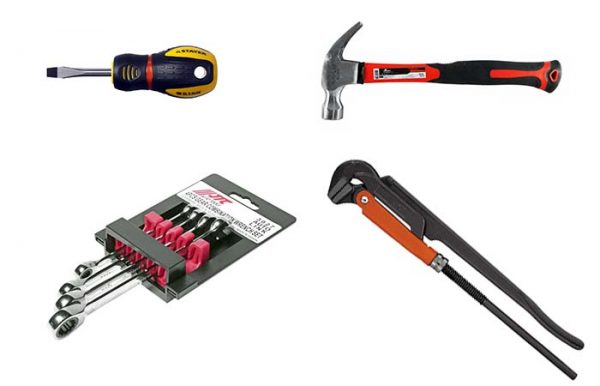

Theoretically, disassembling the exhaust system is not very difficult. However, in reality, the problem of separating the sections usually arises, since the joints of the joints are firmly stuck due to heating and the formation of internal soot.
The resonator is mounted at four points: at two joints (with a front pipe and silencer) and on two rubber hangers hooked directly to the tank. It is dismantled in the following order:
- Drive the car into a viewing hole (flyover), put on the parking brake and secure with wheel chocks.
- Apply a generous amount of spray lubricant to the joints of the resonator section and wait 15-20 minutes.
- Using 13 keys, loosen the rear and front mounting clamps. Carefully knock the mandrels from the thickened part of the joint onto the pipe.

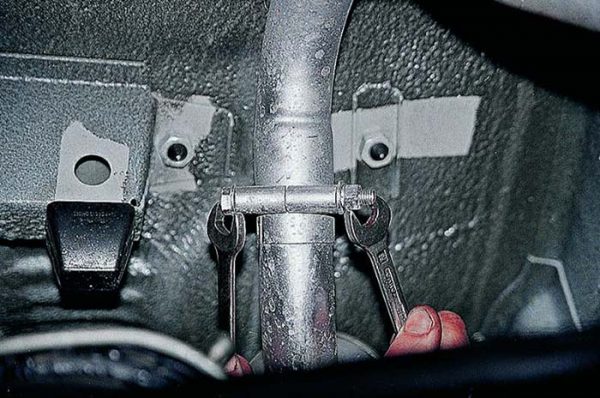 Dismantling begins with loosening the clamp that secures the connection of the resonator with the pipe of the main muffler
Dismantling begins with loosening the clamp that secures the connection of the resonator with the pipe of the main muffler - Using pliers and a screwdriver, unfasten the two rubber hangers.

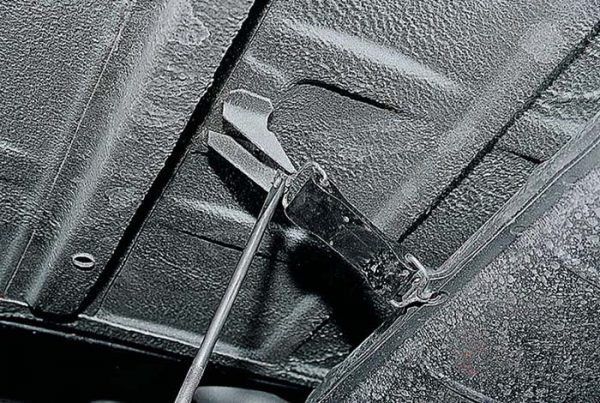 Rubber extensions are easily unhooked from the brackets with a screwdriver
Rubber extensions are easily unhooked from the brackets with a screwdriver - Start disassembly from the rear connection. Having fixed the resonator pipe with a gas wrench, turn the muffler by hand, loosening it up and down.
- Disconnect the junction of the resonator with the pants in the same way. Here you can use a hammer. Attaching a wooden tip to the tank, knock it out with medium-strength blows.

 The tank can be knocked out with a hammer, since the exhaust pipe is screwed to the bottom of the car on the bracket and will not vibrate
The tank can be knocked out with a hammer, since the exhaust pipe is screwed to the bottom of the car on the bracket and will not vibrate
When removing the Euro 2 and 3 resonators, instead of the front clamp, unscrew the mounting flange bolts.
If it is not possible to disconnect the pipes in this way, try to straighten the end of the outer pipe with slots by driving a flat screwdriver under it. When the gap widens, treat the joint again with spray lubricant. If necessary, you can remove the rear suspension of the main muffler and ask an assistant to turn this element while you hold the resonator with a pipe wrench.


The new resonator is installed in reverse order. Before installation, it is recommended to carefully inspect the main silencer and the intake section. If burnouts are found on them, appropriate work should be performed.
During the assembly process, it is necessary to ensure that the pipe does not sag and at the same time does not touch the body. In the first case, the resonator can be damaged on a rough road, and in the second case, it will hit the body while driving, causing a dull thud in the car. Upon completion of work, it is necessary to start the engine and, having descended into the inspection hole, make sure that the joints of the joints do not allow exhaust gases to pass through.
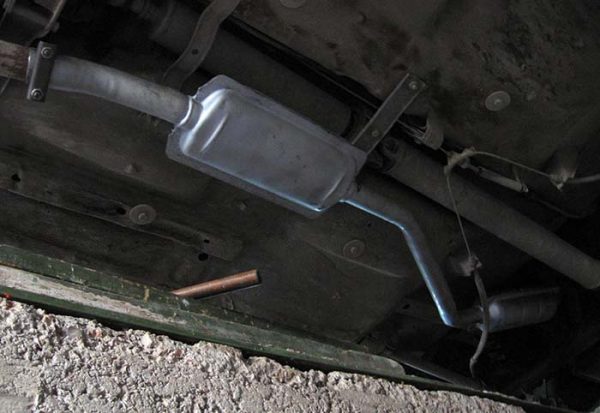

Video: replacing the VAZ 2107 resonator


Watch this video on YouTube
The VAZ 2107 resonator operates in difficult conditions - the temperature of the gases passing through the section is about 600 ° C. If you do not monitor the condition of the rubber fasteners, the pipe will loosen and begin to pass gases. If a fistula appears in the body, the tank should be immediately brewed, otherwise the damage will increase rapidly. Replacing the VAZ 2107 resonator is quite simple. This will require only a minimal set of locksmith tools and step-by-step instructions from professionals.


